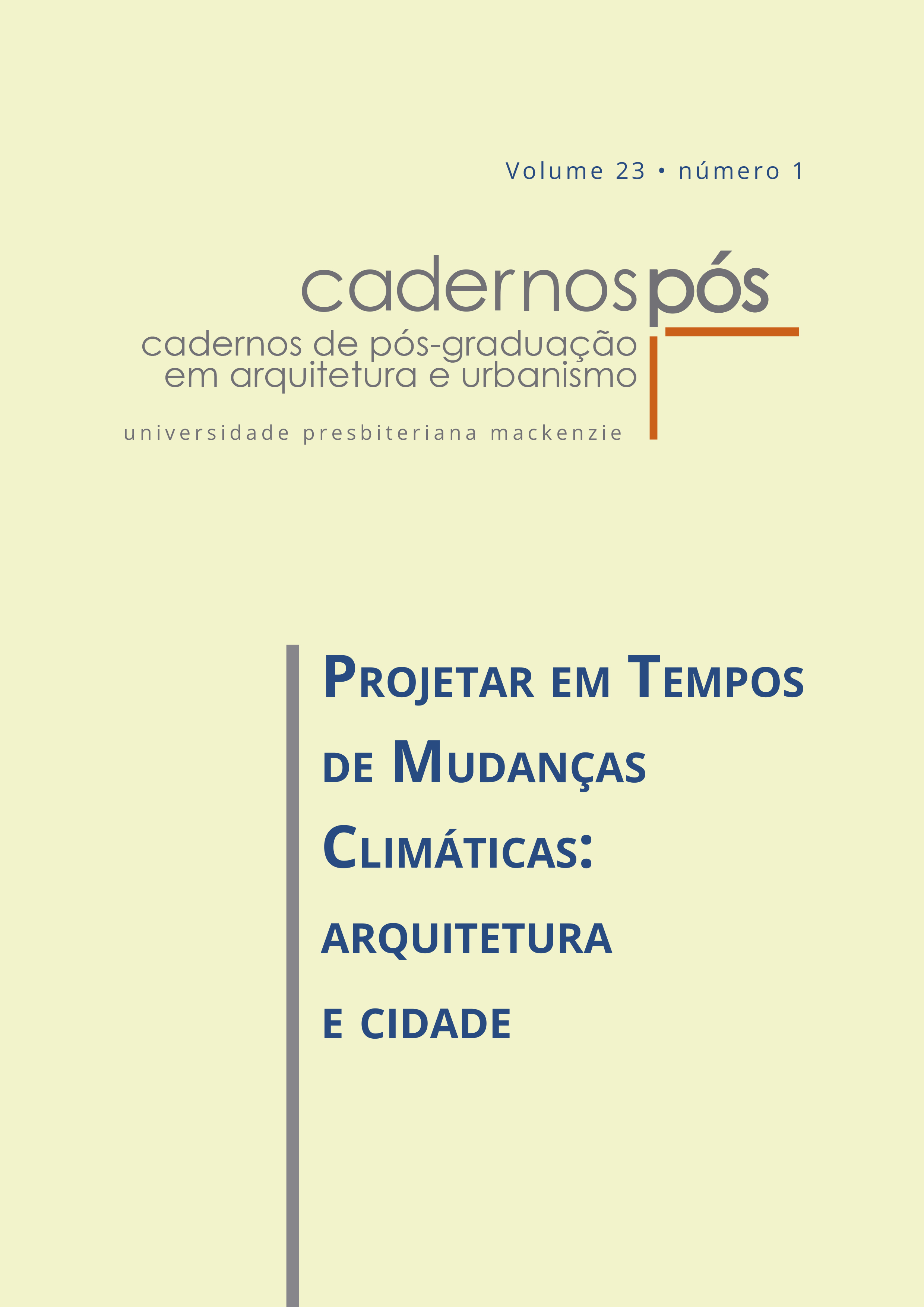Influencia de la morfología urbana en el comportamiento térmico de los edificios
una mirada a las perspectivas climáticas presentes y futuras
DOI:
https://doi.org/10.5935/cadernospos.v23n1p55-69Palabras clave:
Mudanzas climáticas; Confort adaptativo; Cenarios urbanos.Resumen
El cambio climático es un desafío global clave en el siglo XXI y el diseño urbano puede potenciar estos impactos. Este trabajo tiene como objetivo evaluar la influencia del cambio climático en las condiciones térmicas internas de los edificios, considerando diferentes morfologías urbanas. El proceso metodológico consiste en: i) estructurar y definir nueve escenarios urbanos; ii) generación de archivos de clima futuro, tomando como base el RCP4.5 y proyección climática de 2035; y iii) definición de los límites de confort térmico y malestar a través del modelo adaptativo. Los resultados muestran
que el cambio climático impactará en las condiciones internas de los edificios, especialmente en la aceptabilidad térmica de los usuarios. En Cuiabá, los escenarios urbanos 1, 2 y 3 superan el límite superior en septiembre, presentando malestar por calor en el período histórico y en 2035. En Florianópolis, el mes de mayo en el período histórico está por debajo del límite inferior, en 2035 cae dentro del rango de confort, es decir, se vuelve más cálido. Cabe destacar que la influencia de la sombra, como em los escenarios 1A, 2C y 3A del entorno, reduce las horas de incomodidad térmica y aumenta las horas de confort térmico en el módulo.
Descargas
Citas
AMADO, M.; POGGI, F.; AMADO A. R.; BREU, S. E-city web platform: a tool for energy efficiency at urban level. Energies, v. 11, n. 7, p. 1-14, 2018. DOI 10.3390/en11071857
ARBOIT, M.; MESA, A.; DIBLASI, A.; LLANO, J. C. F.; ROSA, C. de. Assessing the solar potential of low-density urban environments in Andean cities with desert climates: the case of the city of Mendoza, in Argentina. 2. part. Renewable Energy, v. 35, n. 7, p. 1551-1558, 2010. DOI 10.1016/j.renene.2009.11.027
ASHRAE. ASHRAE Standard 55: thermal environmental conditions for human occupancy. Georgia, 2013.
BELCHER, S. E.; HACKER, J. N.; POWELL, D. S. Constructing design weather data for future climates. Building Services Engineering Research and Technology, v. 26, n. 1, p. 49-61, 2005. DOI 10.1191/0143624405bt112o
BRASIL. INSTITUTO NACIONAL DE METROLOGIA, QUALIDADE E TECNOLOGIA, (INMETRO). Portaria n° 42, de 24 de fevereiro de 2021. Aprova a Instrução Normativa Inmetro para a Classificação de Eficiência Energética de Edificações Comerciais, de Serviços e Públicas (INI-C) que aperfeiçoa os Requisitos Técnicos da Qualidade para o Nível de Eficiência Energética de Edifícios Comerciais, de Serviços e Públicos (RTQ-C), especificando os critérios e os métodos para a classificação de edificações comerciais, de serviços e públicas quanto à sua eficiência energética. Brasília, DF: Diário Oficial da União, 2021.
EICKER, U.; MONIEN, D.; DUMINIL, E.; NOUVEL, R. Energy performance assessment in urban planning competitions. Applied Energy, v. 155, p. 323-333, 2015. DOI 10.1016/j.apenergy.2015.05.094
FONSECA, J. A.; NGUYEN, T-A.; SCHLUETER, A.; MARECHAL, F. City Energy Analyst (CEA): integrated framework for analysis and optimization of building energy systems in neighborhoods and city districts. Energy and Buildings, v. 113, p. 202-226, 2016. DOI 10.1016/j.enbuild.2015.11.055
GUARDA, E. L. A. da. et al. The influence of climate change on renewable energy systems designed to achieve zero energy buildings in the present: a case study in the Brazilian Savannah. Sustainable Cities and Society, v. 52, n. 101843, 2020. DOI 10.1016/j.scs.2019.101843
INTERGOVERNMENTAL PANEL ON CLIMATE CHANGE (IPCC). Fifth Assessment Report. Genova, Suíça, 2014.
MARTINS, T. A. L.; ADOLPHE, L.; BASTOS, L. E. G.; MARTINS, M. A. L. Sensitivity analysis of urban morphology factors regarding solar energy potential in a Brazil tropical context. Solar Energy, v. 137, p. 11-24, 2016. DOI 10.1016/j.solener.2016.07.053
PEEL, M. C.; FINLAYSON, B. L.; MCMAHON, T. A. Updated world map of the Köppen-Geiger climate classification. Hydrology and Earth System Sciences, v. 11, p. 1633-1644, 2007. DOI 10.5194/hess-11-1633-2007
SARRALDE, J. J.; QUINN, D. J.; WIESMANN, D.; STEEMERS, K. Solar energy and urban morphology: scenarios for increasing the renewable energy potential of neighbourhoods in London. Renewable Energy, v. 73, p. 10-17, 2015. DOI 10.1016/j.renene.2014.06.028
SAVVIDES, A.; VASSILIADES, C.; MICHAEL A.; KALOGIROU, S. Siting and buildingmassing considerations for the urban integration of active solar energy systems. Renewable Energy, v. 135, p. 963-974, 2019. DOI 10.1016/j.renene.2018.12.017
SHI, Z.; FONSECA, J. A.; SCHLUETER, A. A parametric method using vernacular urban block typologies for investigating interactions between solar energy use and urban design. Renewable Energy, v. 165, part. 1, p. 823-841, 2021.DOI 10.1016/j.renene.2020.10.067
TRIANA, M. A.; LAMBERTS, R.; SASSI P. Should we consider climate change for Brazilian social housing? Assessment of energy efficiency adaptation measures. Energy and Buildings, v. 158, p. 1379-1392. 2018. DOI 10.1016/j.
enbuild.2017.11.003
VAN HOOF, T.; BLOCKEN, B.; TIMMERMANS, H. J. P.; HENSEN, J. L. M. Analysis of the predicted effect of passive climate adaptation measures on energy demand for cooling and heating in a residential building. Energy, v. 94,
p. 811-820, 2016. DOI 10.1016/j.energy.2015.11.036
VUKMIROVIC, M.; GAVRILOVIC, S.; STOJANOVIC, D. The improvement of the comfort of public spaces as a local initiative in coping with climate change. Sustainability, v. 11, n. 23, 2019. DOI 10.3390/su11236546
ZHANG, J. et al. Impact of urban block typology on building solar potential and energy use efficiency in tropical high-density city. Applied Energy, v. 240, p. 513-533, 2019. DOI 10.1016/j.apenergy.2019.02.033
Descargas
Publicado
Cómo citar
Número
Sección
Licencia
Derechos de autor 2023 Emeli Guarda, Renata Domingos, Martin Mizgier

Esta obra está bajo una licencia internacional Creative Commons Atribución 4.0.
Autores que publican en esta revista concuerdan con los siguientes términos:
a) Autores mantienen los derechos autorales y conceden a la revista el derecho de primera publicación, con el trabajo simultáneamente licenciado bajo la Licencia Creative Commons Attribution que permite la divulgación del trabajo con reconocimiento de la autoría y publicación inicial en esta revista.
b) Autores tienen autorización para asumir contratos adicionales por separado, para distribución no exclusiva de la versión del trabajo publicada en esta revista (ej.: publicar en repositorio institucional o como capítulo de un libro), indicando que fue publicado originalmente en esta revista, con el enlace del artículo.








 Todo o conteúdo de Cadernos de Pós-Graduação em Arquitetura e Urbanismo está licenciado sob
Todo o conteúdo de Cadernos de Pós-Graduação em Arquitetura e Urbanismo está licenciado sob 